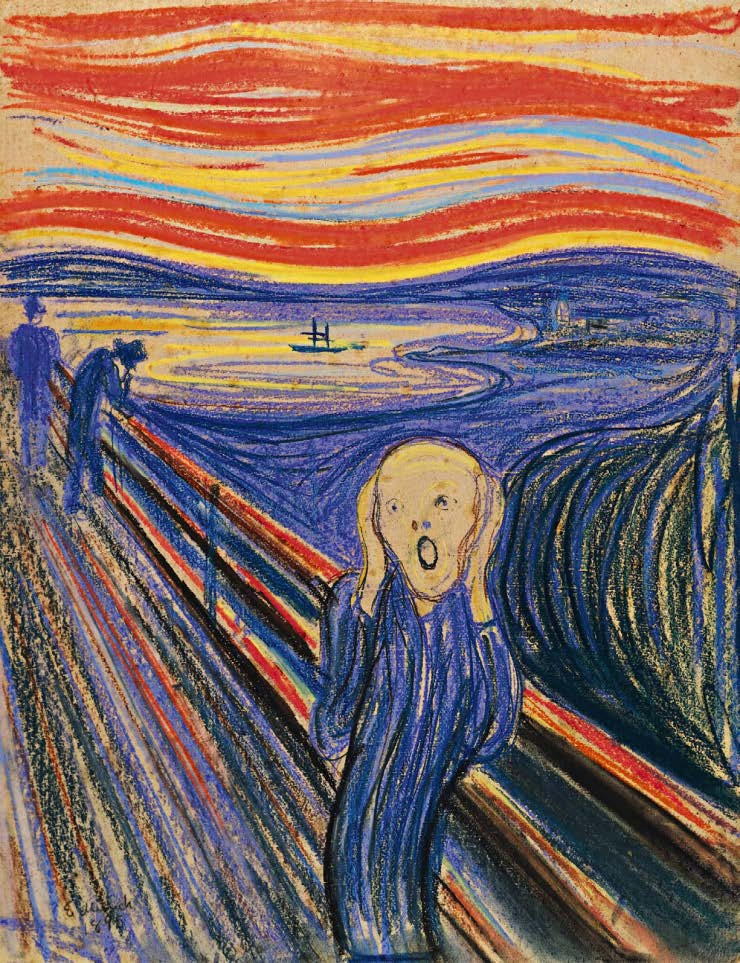ANCORA IMPARO
RICK RADER, MD ■ EDITOR-IN-CHIEF
On the Longevity of The Scream
Screams are a familiar outlet for parents of children with special health care needs. The screams have followed the initial diagnosis, the denial of services, exclusions, unfulfilled promises from school officials, waiting lists, indifferent clinicians, and termination of programs that used to make sense.

Whenever I find myself in in the Orange Grove Center's Art Studio, I get energized. Our art program, under the tutelage of Dennis Wilkes, our artist-in-residence and inspiring art teacher, has a knack for encouraging our artists with intellectual disabilities to find a pathway to expressing themselves. Over the years, many of their paintings could have been displayed in museums, galleries and exhibits. Displayed, not because they were created by individuals with special needs, but simply because of the depth, quality and intensity of their composition. Dennis has stated that when he finds innate talent, he does what other great art teachers have done for centuries – gets out of their way. Paintings have been part of our "humanness" since the Neanderthals smeared red ochre and black pigment on the walls of caves and tried to explain the relationship between humans and lions, buffalos and mammoths; how they found food, found fire, how they survived, and how they evolved. If there is one single painting that captures how an artist can implant an image into the human psyche, it is probably the Mona Lisa by Leonardo Da Vinci. It has been described as "the best known, the most visited, the most written about, the most sung about, the most parodied work of art in the world."
Despite popular opinion, in terms of implanting an image into the human psyche, I think Da Vinci takes a back seat to Edvard Munch, and the Mona Lisa runs close behind The Scream.
While hearing the name of the painting, The Scream, may not immediately connect you to the painting, when you see it, you may immediately realize some familiarity with it. Comments like, "Oh yeah, that guy," "Can't imagine what's going on with him," "That really creeps me out," and "It hurts just to look at it," are clearly a testimony to Munch, who produced the painting in 1893.
As Wilkes remarks, "Get out of their way," this was exactly the concept of the styles of both "naturalism," and "impressionism", the two avenues of composition that Munch explored.
The agonized face in the painting has become one of the most iconic images of art, seen as symbolizing the totality of anxiety, grief, despair, pain, and depression as an overwhelming consequence of being human. Munch described how he came to paint The Scream, "One evening I was walking along a path, the city was on one side and the fjord below. I felt tired and ill. I stopped and looked out over the fjord – the sun was setting, and the clouds turning blood red. I sensed a scream passing through nature; it seemed to me that I heard the scream. I painted this picture, painted the clouds as actual blood. The color shrieked. This became The Scream."
The thing about a "scream" is that it is among the most extreme manifestations of emotion that we have all experienced. How do the screams from witnessing an atrocity compare to the screams of the Beatles fans in 1964? Both may be thought to be comparable to the strange, sexless creature in the foreground of Munch's painting.
There is probably no other painting that has been so widely adopted by popular culture as The Scream. The image has been used on Tshirts, coffee mugs, posters, napkins, coasters, note cards and skin tattoos.
Over the years The Scream has found itself on the cover of dozens of medical monographs on depression, pain, loneliness, stress, suffering, and compassion fatigue. A patient resource group for trigeminal neuralgia (which has been described as the most painful condition in existence) have also adopted the image as a symbol of the condition.
Screams are a familiar outlet for parents of children with special health care needs. Certainly, the screams have followed the initial diagnosis, the denial of services, exclusions, unfulfilled promises from school officials, waiting lists, indifferent clinicians, and termination of programs that used to make sense.
But screams have also followed parents watching their child win an event at Special Olympics, being named the Homecoming Queen, brushing their own teeth, or reaching out to pet a cat, or seeing their child decide on what kind of dessert they want. Screams are nothing more than a loud vocalization in which air is passed through the vocal folds with greater force than is used in regular or close-distance vocalization. This can be performed by any creature possessing lungs. The unique aspect of a scream is the instinctive decision to muster it; the innate desire to designate your response to what conditions you are confronted with, and why it necessitates a scream.
All screams come to an end. Whatever the function of a scream is, to warn, to resign, to surrender, to battle, to confront, it has a life of its own. And so, apparently does Munch's painting. It has been reported that The Scream is deteriorating fast. The demise of the painting is due to two co-occurring conditions. First, the paint was of low quality. Munch used poor paint, resorting to low-quality cadmium sulfide pigments. He also painted it on cardboard.
The other factor, the one I find to be of keen interest is that fans and visitors viewing the painting may be partly to blame. Humidity from the breath of museum goers have gradually degraded the colors of the famous painting. It's as if the heavy breathing of viewers (and heavy breathing is the number one response from experiencing The Scream) is causing it to fade. Onlookers are so troubled, moved and negatively transfixed by the painting that they respond with forceful breaths. Perhaps it is symbolic that the reaction, the concerns, the empathy, the outpouring of emotions that the painting elicits from viewers are sealing The Scream's fate. What if the empathy of supporters in our own lives was enough to diminish the need to scream?
Munch shared his decision to reorient his approach to painting. "No longer shall I paint interiors with men reading and women knitting. I will paint living people who breathe and feel and suffer and love." It's ironic that it is "living people who breathe and feel" that may be responsible for the fading of The Scream. •

ANCORA IMPARO
In his 87th year, the artist Michelangelo (1475 -1564) is believed to have said "Ancora imparo" (I am still learning). Hence, the name for my monthly observations and comments. – Rick Rader, MD, Editor-in-Chief, EP Magazine Director, Morton J. Kent Habilitation Center Orange Grove Center, Chattanooga, TN